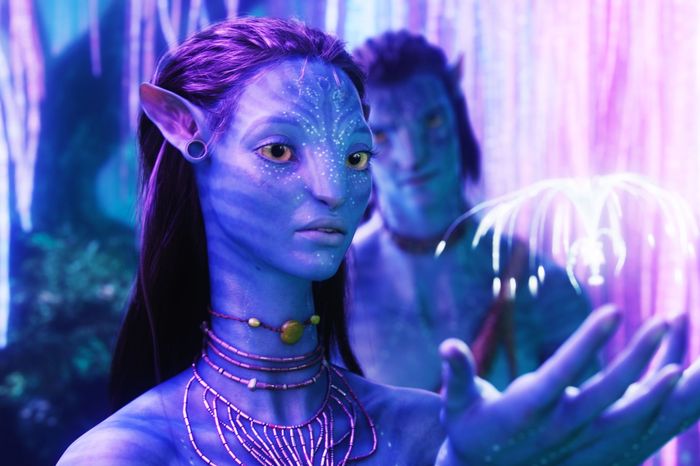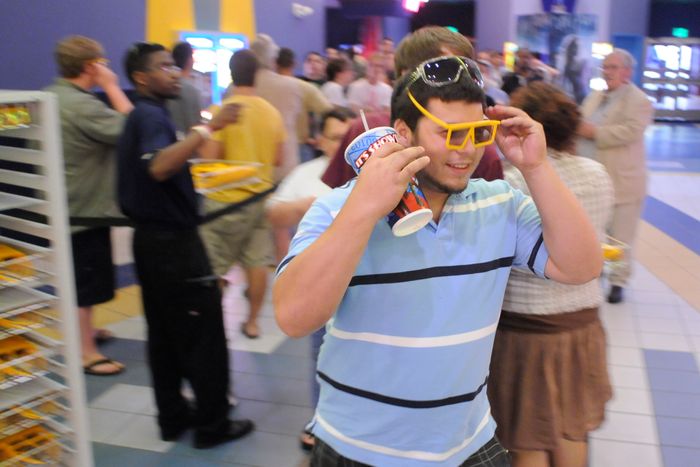
In 2009, Fox’s marketing team posed a $237 million question: How can we make sure that hordes of moviegoers turn out to see an ambitious tentpole about beastly blue humanoids living in a distant land no one has ever heard of? That sum represented Avatar’s hefty budget, which swelled to nearly $400 million once advertising costs were factored in, according to the studio. Some insiders placed the price tag closer to $500 million. Whatever the exact numbers, James Cameron and his backers had a lot at stake. Unlike Disney’s Pirates of the Caribbean: At World’s End (reported budget: $300 million) or Sony’s Spider-Man 3 ($258 million), Avatar couldn’t rely on franchise recognition to sell tickets. Fox needed a more inventive promotional strategy.
Thus something called Avatar Day was born.
In July 2009, while screening footage from the film for the first time at San Diego Comic-Con, Cameron announced that on August 21, four months before the film’s theatrical debut, audiences would be able to see approximately 16 nonsequential minutes at Imax locations around the globe. Following evasive hype about Avatar’s 3-D strides, the public could finally glimpse what one of Hollywood’s primo technophiles had up his sleeve. Admission was free, making it a brand-building exercise with unpredictable payoff. What no one realized was that it would foreshadow the industry’s next phase of full-tilt blockbuster publicity.
“Conventional marketing was unable to convey what was transformational about Avatar,” says Tom Rothman, then-chairman of Fox Filmed Entertainment. “In those days, movie marketing really consisted of trailers, then a barrage of 30-second and 15-second television spots. It’s much more 360 now than it was then. But this was an entirely unique sensory experience. It was generations beyond anything the audience had ever seen, but you couldn’t show that on television. It didn’t translate. We needed to show it in the format in which it was intended.”
From today’s vantage point, this gambit doesn’t seem quite so novel. Last year, Paramount unveiled the first 15 minutes of Top Gun: Maverick at CinemaCon while Disney released four minutes of Jungle Cruise via Dwayne Johnson’s Twitter account. In 2016, Fox stoked enthusiasm for Hidden Figures by previewing excerpts at a spirited Toronto International Film Festival event featuring the teary-eyed cast and a Pharrell Williams mini-concert. And in 2007, Warner Bros. presented six minutes of The Dark Knight ahead of another of the studio’s films, I Am Legend. But asking the general public to trek to multiplexes specifically for a short sneak peek was relatively unprecedented — demonstrating how far movie marketing had come since 1998, when Star Wars fanatics bought tickets to Meet Joe Black or The Waterboy solely to see the Phantom Menace trailer.
To pull off the scheme, Fox struck an economical agreement with Imax: The studio would cover the costs of producing and distributing the digital prints, and Imax would provide around 130 screens and the necessary 3-D glasses. Because this rejuvenated technology was naïvely thought to be the future of cinema (remember Saw 3D?), both companies treated Avatar Day as a major awareness-raising activation. If all went well, executives hoped, more theaters would be inspired to install 3-D configurations. They were right — to a degree. (Fox hoped for “hundreds” more than they actually got, per the New York Times.)
“As the marketing organization started to see more and more finished footage, we had to stop being afraid of nine-foot-tall people (who aren’t really people) and start immersing everyone in the world,” says Rita Drucker, former senior vice-president of Fox’s theatrical partnerships. “You can talk all you want about the innovation — how cool the 3-D is going to be — but at some point, you’ve got to show people. There was enough of the story in those 16 minutes that had the spectacle, the emotionality, the character beats, and some of the more relatable moments.”
The goal, Drucker recalls, was to set up Avatar to earn more than Cameron’s previous film, Titanic, whose voyage had reaped $1.84 billion worldwide — in other words, to make it the highest-grossing title of all time. No biggie.
The plan was for Imax venues to host two consecutive previews — most occurring between showings of Harry Potter and the Half-Blood Prince, according to the Times. Tickets, made available through Avatar’s website, were snatched up so feverishly that some theaters ended up scheduling more than two. “Those are the people who will spread the gospel of Avatar and of Imax and of the movie business,” Imax Filmed Entertainment’s then-president Greg Foster told the Times.
The event began with a prerecorded message from Cameron, after which six handpicked scenes and an action montage transported viewers from the ravaged, futuristic Earth that opens the film to the lush Na’vi moon Pandora. The clips featured paraplegic ex-Marine Jake Sully (Sam Worthington) learning about the Na’vi species, becoming an ambulatory avatar with counsel from Dr. Grace Augustine (Sigourney Weaver), and encountering various creatures native to Pandora.
“Counter to what people might have previously said about James Cameron being mercurial or difficult, he could not have been more supportive, collaborative, and gracious,” Drucker says. “He saw the value in what we were doing, and he was incredibly supportive of the marketing team — at least from my personal experience.”
Naturally, Avatar Day didn’t end with Imax. A video-game trailer and Mattel action-figure set debuted. In subsequent months, multimillion-dollar promotional tie-ins with McDonald’s, Coke, LG, and Panasonic manufactured louder momentum. But corporate merchandising was nothing new in Hollywood. The preview events were what broke ground — and yet it’s hard to imagine another non-franchise director packing theaters for a mere 16 minutes. Could Christopher Nolan? Quentin Tarantino? Jordan Peele? Debatable. “There’s an expectation from moviegoers that Cameron is always going to do something completely unexpected and new,” Drucker says.
As Fox and Imax had hoped, enough Avatar Day spectators walked away with heightened curiosity. A 24-year-old named Anthony Morales told the Tampa Bay Times, “It was unlike anything I’ve ever seen. It’s different. I don’t have the words for it. I’m speechless.” Some of Cameron’s peers were inquisitive too: Guy Ritchie, prolific producer Joel Silver, Marvel chief Kevin Feige, and former Paramount vice-chairman Rob Moore reportedly attended screenings in various locations.
But for Adam Bowie, a London-based cinephile who currently works for the BBC, the preview had the opposite effect. Having attended one of the energetic showings at the BFI Imax in Waterloo, he wrote on his blog that he would “certainly go and see this film when it comes out.” But between August and December, he realized he wasn’t actually all that compelled by what he’d watched. To this day, he has still never seen Avatar.
“I’m not gonna rain on anyone else’s parade, but weirdly, the thing failed for me,” Bowie says 13 years later. “I came away a bit nonplussed about it. It felt like a computer game to me. I wasn’t at all bowled over by the 3-D. You’re talking to someone who certainly does go to the cinema a lot, but I just didn’t find the thing interesting.”
Bowie wasn’t alone. As Entertainment Weekly’s John Young wrote, “I think we’re all going to be watching Avatar from a distance, desperately trying to figure out why a film with such mesmerizing visuals still doesn’t feel quite right … I talked to several attendees after the screenings, and the general consensus was that the footage looked impressive but not revolutionary. Everyone said they were glad to have made the trek to see it, though.”
Apathetic responses were, and possibly remain, Avatar’s hurdle. Even though its box-office grosses exceeded Drucker’s lofty expectations ($2.91 billion globally, buoyed by inflation and 3-D surcharges), the movie’s cultural narrative coalesced around its technology — including the trailblazing motion-capture methods Cameron and his collaborators instituted. The director’s clout sold tickets, but it could only do so much for the film’s emotional resonance. Avatar has plenty of die hards, as evidenced by recent rerelease revenue, yet there’s no denying that its vernacular and aesthetics failed to achieve the same saturation as cash cows like Star Wars, Jurassic Park, Harry Potter, The Godfather, and Marvel. Come December, when the first of four planned sequels hits theaters, we’ll find out whether there are more Anthony Moraleses or Adam Bowies in the world. For now, Avatar personnel are back to their old ways, having just presented 15 minutes of this year’s Avatar: The Way of Water at a sold-out event at the Busan International Film Festival.
“We knew it was risky,” Rothman says of Avatar Day. “But the whole project was risky. We believed we had the goods, and we believed in Jim Cameron. You’re not going to do it if you didn’t really believe that what people were going to see and experience would be special.”
More From This Series
- All of the Avatar Sequel Announcements: A Timeline
- Inside Avatar’s Losing Battle to Beat The Hurt Locker for Best Picture
- Critical Reactions Vary More Than the Frame Rates on Avatar: The Way of Water





